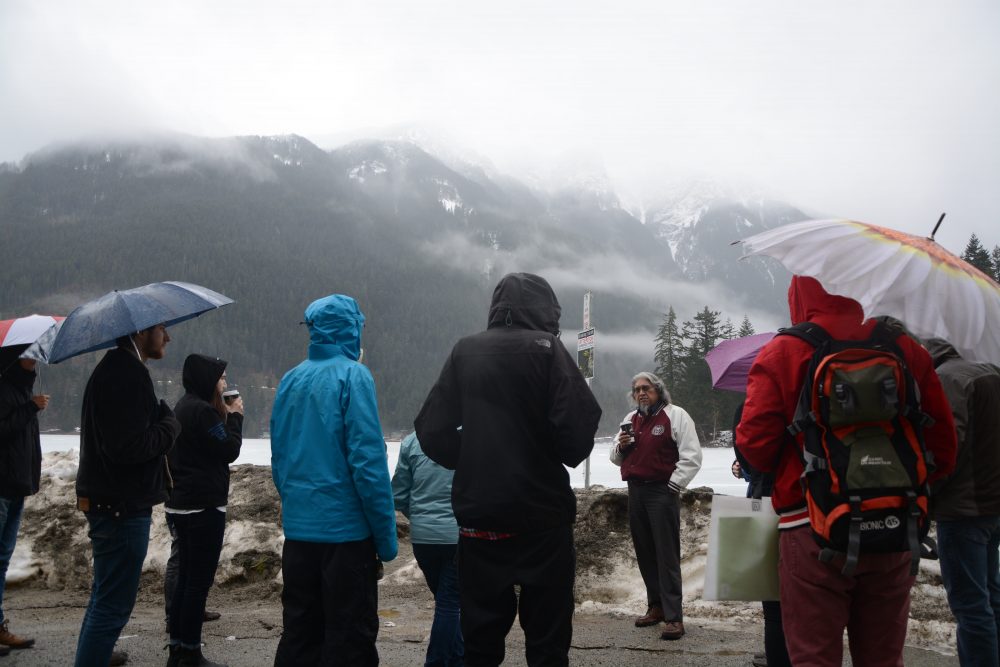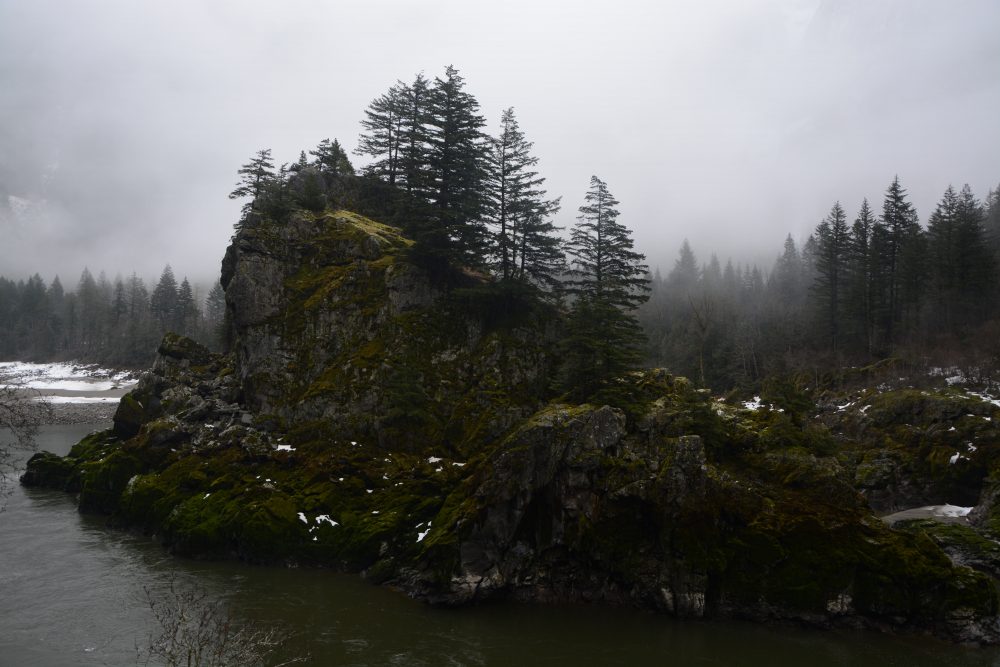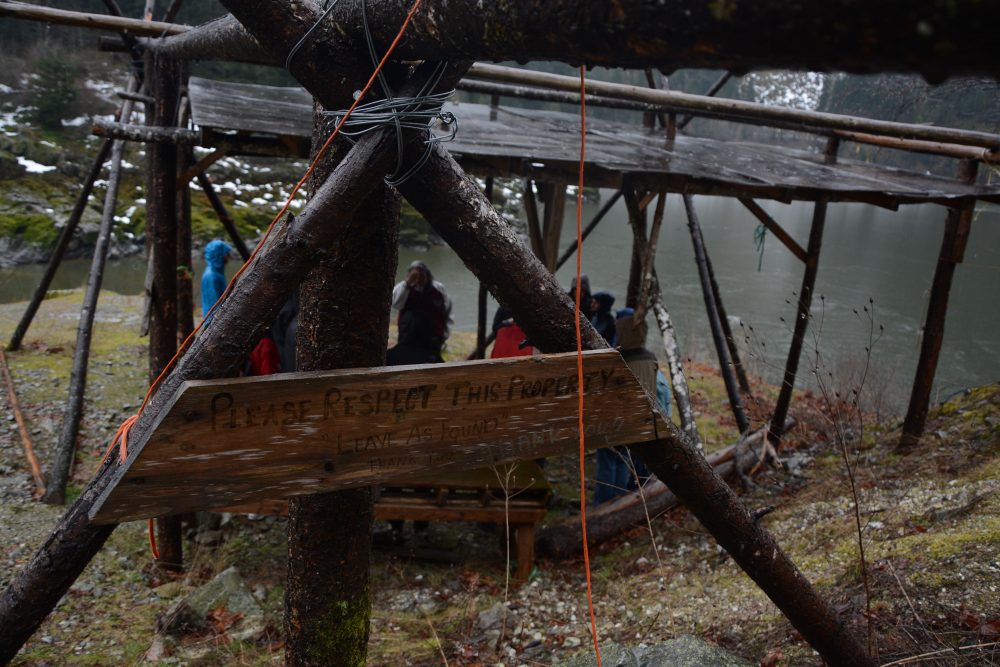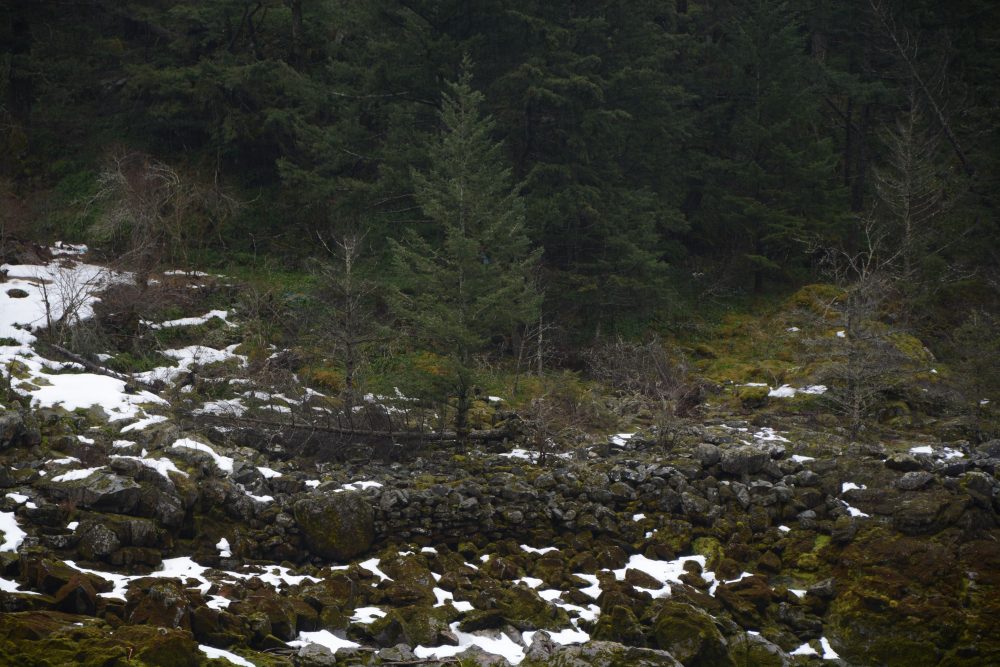My family used to migrate to the Coquihalla Campground in Hope, B.C. for a one-week caper each summer. Long days were spent shredding the local skatepark or bumming money from my mom to buy candy and play Street Fighter in the windowless trailer campground arcade. In the late afternoon my brother and I marched shirtless over the levee and across the rocky bank with unreliable swimming goggles sucked to our eye sockets, and waded into the summer-sedated Coquihalla River. The water was knee deep and warmed from a full day of sun exposure. We coasted in the current, either face down fingering the riverbed or reclined, skipping over smoothed boulders. Five minutes of this brought us to the swimming hole. Here, a chest deep sand estuary cuts into the bank where river water circulates and grows tepid, and where children belt “Marco Polo” while their toddler siblings wander naked along the murky shoreline.
The swimming hole is cradled by a large rock bluff that scoops alongside the sand dune and reaches into the river. The current cuts down against the bluff and narrows into a deep emerald surge. The water where the river and cliff meet is clear and cool, deep enough to sprawl vertically underwater. My brother and I used a convenient shelf in the cliff-face to scramble across and swim circuits in the channel, diving upstream to be ferried back down by the current, observing the veins of sunlight that pulsed against the crag.
We didn’t know it then, but the Stó:l? First Nations used this rock shelf as a prime fishing spot for countless generations, and it has a very particular name: Kw’ikw’iya:la, which in Halq’emeylem means “stingy container.” The name Kw’ikw’iya:la had an attractive sound to Western settlers; exotic perhaps, hinting at a mysterious history that was nearly (and according to most, inevitably) squelched. The name was appropriated as a generic slogan for most of the place markers in the surrounding area. The wagon road became the Coquihalla Highway, campgrounds and coffee shops, hotels and corner stores — everywhere an adage was needed to indicate some sort of “Canadian” authenticity, the name Coquihalla was enthusiastically appointed, eventually becoming the airy mascot of the mountain pass.
Tour stop at Kawkawa Lake, the place of origin for the sacred sxwó:yxwey mask.
“I wonder if any of the people who use the name Coquihalla know what it really means,” exclaimed Dr. Naxaxalhts’I from the front seat of the tour bus. “It’s just the name of our fishing hole, our little ‘stingy container’.”
Stó:lo historian and cultural advisor Naxaxalhts’I (pronounced Nakahaltsi), also known as Sonny McHalsie, recently guided his renowned Place Names tour for a rather exclusive entourage of American geographers and I managed, with persistence and luck, to coerce my way along for the ride. The tour was an all-day romp up the Fraser Valley, from Abbotsford to Yale, brimming with hundreds of traditional Swelqwels (true stories), and Sxowxiyám (legends).
Arranged by the Geography Club of Washington, the tour was initially slated to depart from Bellingham before the U.S. elections made border crossing slightly more hairy. So, in true Canadian fashion, UFV hosted the club and its multi-day exhibition, erecting information booths where student volunteers handed out pad-and-pen outfitted tote bags and ushered guests to their intended public speaking event or horticulture forum. A succession of local tours took place during the first weekend of March, a fleet of buses departing for sights of geographical interest, of which the Place Names tour was the most popular. I had heard of the talented storyteller and published historian Sonny McHalsie, and was eager to learn more about the history of this strangely enigmatic land we call home.
As a settler nation, we perpetuate the myth that rich history is exclusive to other, older countries. Canada is young after all, only 150 years this July. Canadians travel to Europe seeking history and culture almost as a rite of passage. It’s easy to ignore the fact that we are only a handful of generations away from colonization, and before our ancestors swarmed this land in the name of religion and greed, there was a thriving society established here with a rich culture, deep heritage, a fastidiously arranged economy, and an all-encompassing religion of its own; it’s even easier to ignore the fact that those traditions never went anywhere. Aboriginal culture still thrives within a recovering and growing community. Indigenous history is inseparably suffused within every stone and brook and square-inch of this land.
The Place Names tour is all about making the invisible visible. Knowing the history of our home will help us view this land with clarity and wisdom, will foster understanding and respect, and will challenge us to comprehend our role as an individual in the world, not as an inconsequential frolic or inimitable snowflake, but as an integral pinion latching the future to history with a responsibility to both. Reclaiming the names of the country’s landmarks is the first step in the difficult process of decolonization.
I arrived on campus in the muted grey dawn and weaseled into the last seat on the bus. Naxaxalhts’I quietly boarded toting a cotton sac overflowing with apples. The bag had an external pouch from which he consistently plucked tablets of Fisherman’s Friends. He was large, over six feet tall, with steady hands and a cultivated but greying goatee. He was also endearingly calm and soft-spoken; having to orate above the rolling bus’ thrum strained his voice, hence the lozenges.
The tour began at eight a.m. A thick mist lidded the valley and rain prattled against the windshield as we merged eastward onto the freeway.
“When our chiefs used to meet to discus land questions,” said Naxaxalhts’I, turning to face the group for the first time, “they would begin by reciting a very important statement: ‘S’ólh Teméxw te ikw’elo. Xolhmet te mexw’stam it kwelat,’ meaning: ‘This is our land and we have to take care of everything that belongs to us.’ It is a profound statement and something that is very important. The second part of that statement, that we have to take care of everything that belongs to us, sparked my interest when I first heard it in 1988, and it sent me on a lifelong journey to discover what the chiefs meant. All of the narratives I will be providing today compile a comprehensive list of the things that are out there that we need to take care of.”
Passing through Chilliwack, we learned that the original Halq’emeylem name for the area is T??l?wæk (pronounced chalwheyak), meaning “backwaters.” Before the installation of dikes, the Chilliwack Valley was entirely flooded. Sporadic plots of land surfaced from the vast backwaters, creating an intricate bayou flush with wildlife. Aboriginal ancestors used to paddle their canoes through the T??l?wæk, watching the spines of silver sturgeon cut the water’s surface.
Looming above the valley stands the vaulted buttress of Lhílheqey — Theeth-uhl-kay — otherwise known as Mt. Cheam. “Mt. Cheam is the Western name for Lhílheqey. Cheam comes from the word luthcheam, which means ‘always wild strawberries’,” Naxaxalhts’I explained. Lhílheqey was a woman from the valley who fell in love with a man from the south. She lived with him in his home and together they had six children; three boys and three girls. Lhílheqey grew restless in her old age and longed to return to her home, and so along with her three daughters and followed by her faithful dog, she returned back to the valley, where the transformers Xexá:ls immortalized her in stone and entrusted her with the responsibility of watching over the people in the valley, and to take special care in watching over the salmon. Lhílheqey’s husband is Mt. Baker, and the rest of her family establishes much of the Cheam range, each with a unique history that pertains to its individual characteristics.
Xéylxelamós: a shxwla:m (medicine man) who used his power to benefit himself and so was transformed by Xexá:ls, the transformer, into this large rock. Xéylxelamós is known to some as Lady Franklin Rock.
I am amazed at the volume of stories that the Stó:lo people have for the land. It isn’t simply legends about mountains and valleys; Naxaxalhts’I related specific histories for every landmark imaginable. One of the Swelqwels (true stories) that we heard was the history of the dangerous warrior Tómtomiyéqw.
Many years ago in Alámex (Agassiz), a young boy was left in charge of his infant sister while the rest of his tribe went berry picking. The young girl wouldn’t stop crying, and the boy couldn’t calm her. Angry and distraught, the boy threw his sister into the longhouse fire. When the tribe returned they were horrified to discover the child burned. The boy grew up fierce, and no man in his tribe would dare to say anything against him. He always carried a long club, and he began attacking visitors from other tribes wanting to trade. Revenge raids from the coast were immanent after the young man slaughtered a trading party. This forced his family to disperse and flee upstream. They banished the violent young man, who later became known as Tómtomiyéqw. Living as a hermit, Tómtomiyéqw lingered at the mouth of his cave above the Fraser River. He watched for canoes paddling upstream and, once in sight, he’d silently descend from his perch and hide beneath a bullrush mat in a river eddy. Once the coastal canoe was within reach, Tómtomiyéqw would capsize the boat and swiftly climb onto the upturned hull. From here Tómtomiyéqw bludgeoned the passengers to death as they clung to the sides of the craft.
“A few years ago when I told this story,” relates Naxaxalhts’I wistfully, “I had a girl on my tour who was from a tribe on the north end of Vancouver Island. She remembers how her elders used to talk about this story, how they used to warn their tribesman about the crazy man who lived in a cave near Skw’iytel. Well, Skw’iytel is a little bit down river, but I’m pretty sure they were talking about this place.”
A unique and especially entertaining genre of Stó:lo narratives are the tales of Mink. These are essentially dirty stories; yarns of debauchery recanted with rascal glee, but intended as cautionary lessons about how not to behave. “There was a young man who was training to be a shxwlá:m, which is an Indian doctor,” Naxaxalhts’I said with a sly smirk as we neared Hope. “Xex:als the transformer came along, and he asked that young man, ‘What is your spirit power?’ Every Stó:l? individual gets a spirit power once they reach puberty. Shxwlá:m have to gain multiple spirit powers to become Indian doctors. When Xex:als the transformer asked that young shxwlá:m what his spirit power is, the young man whipped out his penis and said ‘Here is my spirit power.’ Xex:als transformed him into his spirit power, so now when you walk along the bank of the river you’ll see a large, smooth boulder that is four meters long and one meter in diameter.”
As the day wore on, I listened to numerous tales, legends, and histories and I became convinced that the Stó:l? people are not only breathtaking storytellers, but also unparalleled horror story raconteurs. “Stl’áleqem is a Halq’emeylem word that means supernatural creature,” murmured Naxaxalhts’I provocatively. “The double-headed snake, the little people, underwater babies, the bear that lives beneath Cultus Lake, the giant maggot, the glowing red eyes that come out after dark. These things and so many more live amongst us, out there in the wild… when you feel the hair raise on the back of your neck and you know something is watching you; that’s the Stl’áleqem.” The phrase “supernatural creatures” is certain to bring one specific name to the mind of most non-Indigenous people: the infamous Sasquatch.
“In 1999 I asked for a meeting with Elizabeth [Herrling] and Rosaline [George] to talk about the Stl’áleqem, which at that time I had very little knowledge of. It was for a Halq’emeylem Place Names atlas I was getting ready to put together. So when I met with them and the elders, I started by saying, ‘Alright I want to talk about the Stl’áleqem…’ So I looked at my list and said ‘Sasquatch.’ I’ll never forget the big scowl I got from Elizebeth Herrling when she looked at me and said, ‘Sasquatch is not a Stl’áleqem. Sasquatch is real; it’s just that you young people don’t believe in it anymore’.” It was Rosaline George who explained to Naxaxalhts’I what a Sasquatch is.
Indian doctors need to set out alone to scour the wilds, meditate, and pray, entreating ancestors and Stl’áleqem to endow them with a spirit power. Only once he has gained multiple spirit powers can the man return to his tribe as a complete and capable shxwlá:m. This can take decades. Some people who set out to become an Indian doctor never return. Those people, the lost shamans, they are the Sasquatch. Naxaxalhts’I did recant one especially impressive Stl’áleqem story that I am sure I will never forget.
Naxaxalhts’I relating Stó:lo oral history beneath a salmon dry-rack in Yale.
We peeled off the Trans Canada Highway, banking down a rutted cliff’s-edge road above the Fraser River. We were in Xwoxwelá:lhp (Yale), heading to our last stop of the trip. Sunlight cleaved vaguely through the overcast gully and the bus careened top-heavy around each blind corner when Naxaxalhts’I leaned his head into the bus’ aisle and stared back stoically.
“Th’?xiya (T-ho-kwee-ya),” he murmured, exhaling the word like smoke. He waited another hefty moment. “Th’oxiya, the cannibal woman. She lived in a cave up here, though none of the elders were able to say which one. At nightfall she hoisted her basket and walked the shoreline, watching for kids that were out playing after dusk. She would creep up and snatch them, stuff them into her basket, carry them back to her cave where she would pitch their eyes shut so they couldn’t run away, sing and dance her song, cook the kids over the fire, and feast.”
A group of local kids thought they were pretty smart. They posted a lookout, the youngest boy, to keep watch for the cannibal woman while they played on the beach and froliced in the rosy waters of arrogance. Well, needless to say, they got what was coming to them.
“Instantly Th’oxiya was there; instantly she snatched them and put them into her basket,” Naxaxalhts’I said. The children tried various stunts to escape, each attempt thwarted by bad luck, until the final moment arrived; the children were commanded to sing and beat on a long log-drum while Th’oxiya danced around the fire celebrating her impending feast. The kids brandished the log-drum and bulldozed her into the open flame.
“The fire was almost out when two men approached, both cold and hungry. They wanted to get the fire going to cook their hunted meat. The first man approached the fire and blew into the embers. The fire torched up and burned his chest, and that man became the black bear with the white spot on its chest. The fire immediately died down, so the second man approached the fire and blew. The fire flared into the sky and scorched the entire front of his body, and that man became the red robin. The countless cinders that erupted from the immense flame became the mosquitos. Just like Th’oxiya who came out at dusk, the mosquito comes out at dusk. Just like Th’oxiya was the cannibal woman, the mosquito drinks your blood. Just like Th’oxiya who sings her song before she feasts, that’s the song you’ll hear the mosquitos sing just before they bite you.”
The road ended atop a flat outcropping in the cliff. A salmon-drying rack sat stilted on hemlock posts overlooking the Fraser. The river cut an immense gorge through the menacing mountain pass. Perched across the river was another salmon-drying rack. Beside the rack, camouflaged from anyone unsure of what to look for, leaned a conspicuously precise stack of boulders, standing one meter high and spanning nearly half a dozen metres of the river bank. It was an ancient rock palisade constructed by Stó:l? ancestors, used to defend against the coastal raiders. The surrounding mountainsides are rife with similar stone blockades. On the inside of the rock walls, archaeologists found stacks of fist-sized boulders. Fired from a long leather sling, these stones could split through two sides of a canoe. On the exterior of the walls were hundreds of broken arrowheads.
Standing at the base of the wild mountainside and staring uphill, you can view a daunting arrangement of rock walls. In the river behind you is a massive boulder protruding from the middle of the waterway, all that remains of a mighty Indian doctor Xéylxe-lamós who did battle with Xexá:ls the transformer before being turned to stone. Downstream are the three smooth boulders of the three boys who were transformed after swimming past sunset. Around the bend upstream is the whirlpool that leads to the mysterious underworld connected to the mountain cave above.
An ancient rock wall used by Stó:lo ancestors to defend against coastal raiders.
We live in a country that has a history almost too deep to comprehend. Halq’emeylem history has its roots in every ounce of valley soil. The stories I witnessed are survivors of countless millennia, of war and famine, of a smallpox epidemic that devastated entire villages, wiping out between 60 and 90 per cent of the Aboriginal community. Imagine what was lost. It’s feasible to imagine every stone having once been a boulder with its own story, and that each granule of sand is the fragment of a living mountain. When a society survives on the premise that the earth is comprised of living beings, and that “every object has its own soul or spirit,” the inevitable result is a relationship with the land that most other traditions would struggle to fathom.
We arrived at UFV as the sun dropped behind the tree line, and it was as dim as when the tour began. Each of the passengers silently lurched off the bus, sore and bleary from a full day. Naxaxalhts’I gathered us into a circle for one last departing huddle. He held his upturned palms in front of him and we each intuitively did the same. “S’ólh Teméxw te ikw’elo. Xolhmet te mexw’stam it kwelat. This is our land. We have to take care of everything that belongs to us. We have to take care of it. Nobody else can. It’s ours. We have to. We must.”






